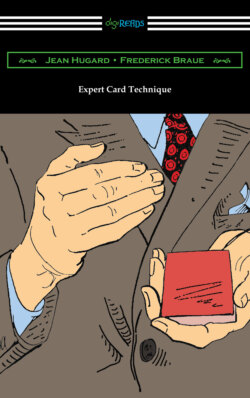Читать книгу Expert Card Technique - Jean Hugard - Страница 60
На сайте Литреса книга снята с продажи.
CHAPTER 6. FALSE SHUFFLES THE PERFECT RIFFLE SHUFFLE
ОглавлениеThe master minds of card conjuring, those who aspire to the heights of virtuosity in the handling of cards, have sought for years to master the perfect riffle shuffle; that is to say, to make the shuffle by interweaving the two packets card for card. By dint of incessant practice some performers have attained sufficient skill to make the perfect shuffle some four times out of five but, in spite of all attempts they cannot acquire an absolute certainty of success. By resorting to a subterfuge, however, not only is all this tedious practice eliminated, but success is assured every time. The following very easy method, which exactly simulates the movements of the riffle shuffle, is actually an application of the principle of the weave. With it, as with the Perfect Faro Shuffle, a pack can be brought back to its original condition after eight shuffles.
a. 1. Place the hands over the tabled pack, the second and third fingers at the outer side close to the corners, the first fingers resting on the top, the thumbs at the inner sides near the corners.
2. Cut the pack into two packets, A and B, placing the upper half (B) to the right, the inner ends of A and B parallel and touching but with B three-eighths of an inch beyond A, as shown in the small drawing, Fig. 1.
3. Place the tips of the little fingers against the ends at the outer corners. Both packets are boxed in at these corners by the second, third and little fingers, the extreme tips of which press firmly against the table top and maintain the same position throughout the action to follow, Fig. 1.
4. Lift the inner sides with the thumbs, retaining the position of the fingers and thus mooring the outer corners of the pack in the two right-angle vises formed by the three fingers of each hand. Press firmly with the first fingers against the backs of the packets. By means of an outward pressure of the thumbs at the inner sides, swivel the two packets a quarter of an inch outward, the inner corners of A and B now making the only contact between the two packets, Fig. 1.
5. Remove the first fingers of both hands and relax the pressure of the thumbs at the sides, holding the packets very lightly. This relaxation of pressure will cause the two packets to commence weaving together at the bottom.
6. Move packet A outward, packet B inward, as indicated by the arrows in Fig. 1. The change of position of the inner corners of the two packets makes the meshing of the cards, swiftly and exactly, a complete certainty. At the end of the mesh the packets are still supported by the thumbs, save for the few at the bottom which, interweaving, may have dropped to the table.
7. Immediately run the thumbs of both hands up the sides of the cards, producing the riffling sound associated with the riffle shuffle, the cards dropping off the thumbs to the tabletop, Fig. 2.
The entire action is made possible by the peculiar grip at the corners with the second, third and little fingers, this boxing of the outer corners producing a tension at the inner corners when the packets are moved into the position shown in the figure, this tension making the perfect mesh possible.
b. Another method is to make the shuffle as follows:
1. Cut the pack, placing the two packets with their ends parallel and touching, as in Fig. 2.
2. Place the tips of the little fingers against the ends at the outer corners. Both packets are boxed in at these corners, as in the preceding method, by the second, third and little fingers, the tips of which press on the table top and maintain the same position throughout the shuffle. The thumbs, as shown in the illustration, are at the middle of the inner sides.
3. Lift both packets with the thumbs and press outwards, as shown in the ghost illustration in Fig. 2. The touching inner corners press against one another.
4. Relax the pressure of the thumbs, allowing the cards to mesh at the corners, at the same time moving the thumbs upwards to simulate the usual action of the riffle shuffle. The interwoven cards, dropping off the thumbs, produce the characteristic riffling sound of the regular shuffle.
This method is used by Charles Miller.
